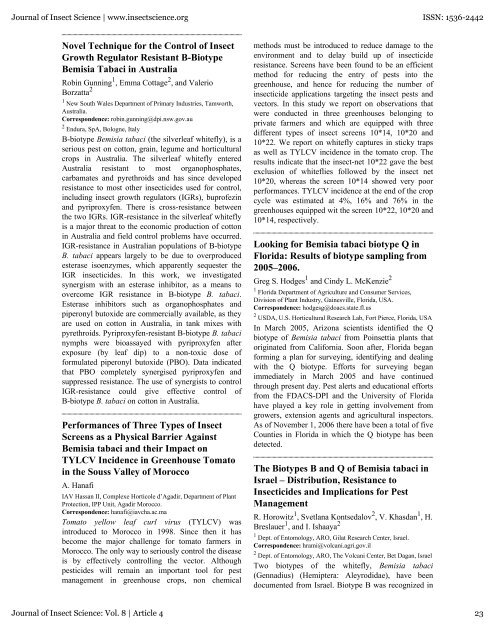Fourth International Bemisia Workshop International Whitefly ...
Fourth International Bemisia Workshop International Whitefly ...
Fourth International Bemisia Workshop International Whitefly ...
Create successful ePaper yourself
Turn your PDF publications into a flip-book with our unique Google optimized e-Paper software.
Journal of Insect Science | www.insectscience.org ISSN: 1536-2442<br />
Novel Technique for the Control of Insect<br />
Growth Regulator Resistant B-Biotype<br />
<strong>Bemisia</strong> Tabaci in Australia<br />
Robin Gunning 1 , Emma Cottage 2 , and Valerio<br />
Borzatta 2<br />
1 New South Wales Department of Primary Industries, Tamworth,<br />
Australia.<br />
Correspondence: robin.gunning@dpi.nsw.gov.au<br />
2 Endura, SpA, Bologne, Italy<br />
B-biotype <strong>Bemisia</strong> tabaci (the silverleaf whitefly), is a<br />
serious pest on cotton, grain, legume and horticultural<br />
crops in Australia. The silverleaf whitefly entered<br />
Australia resistant to most organophosphates,<br />
carbamates and pyrethroids and has since developed<br />
resistance to most other insecticides used for control,<br />
including insect growth regulators (IGRs), buprofezin<br />
and pyriproxyfen. There is cross-resistance between<br />
the two IGRs. IGR-resistance in the silverleaf whitefly<br />
is a major threat to the economic production of cotton<br />
in Australia and field control problems have occurred.<br />
IGR-resistance in Australian populations of B-biotype<br />
B. tabaci appears largely to be due to overproduced<br />
esterase isoenzymes, which apparently sequester the<br />
IGR insecticides. In this work, we investigated<br />
synergism with an esterase inhibitor, as a means to<br />
overcome IGR resistance in B-biotype B. tabaci.<br />
Esterase inhibitors such as organophosphates and<br />
piperonyl butoxide are commercially available, as they<br />
are used on cotton in Australia, in tank mixes with<br />
pyrethroids. Pyriproxyfen-resistant B-biotype B. tabaci<br />
nymphs were bioassayed with pyriproxyfen after<br />
exposure (by leaf dip) to a non-toxic dose of<br />
formulated piperonyl butoxide (PBO). Data indicated<br />
that PBO completely synergised pyriproxyfen and<br />
suppressed resistance. The use of synergists to control<br />
IGR-resistance could give effective control of<br />
B-biotype B. tabaci on cotton in Australia.<br />
Performances of Three Types of Insect<br />
Screens as a Physical Barrier Against<br />
<strong>Bemisia</strong> tabaci and their Impact on<br />
TYLCV Incidence in Greenhouse Tomato<br />
in the Souss Valley of Morocco<br />
A. Hanafi<br />
IAV Hassan II, Complexe Horticole d’Agadir, Department of Plant<br />
Protection, IPP Unit, Agadir Morocco.<br />
Correspondence: hanafi@iavcha.ac.ma<br />
Tomato yellow leaf curl virus (TYLCV) was<br />
introduced to Morocco in 1998. Since then it has<br />
become the major challenge for tomato farmers in<br />
Morocco. The only way to seriously control the disease<br />
is by effectively controlling the vector. Although<br />
pesticides will remain an important tool for pest<br />
management in greenhouse crops, non chemical<br />
methods must be introduced to reduce damage to the<br />
environment and to delay build up of insecticide<br />
resistance. Screens have been found to be an efficient<br />
method for reducing the entry of pests into the<br />
greenhouse, and hence for reducing the number of<br />
insecticide applications targeting the insect pests and<br />
vectors. In this study we report on observations that<br />
were conducted in three greenhouses belonging to<br />
private farmers and which are equipped with three<br />
different types of insect screens 10*14, 10*20 and<br />
10*22. We report on whitefly captures in sticky traps<br />
as well as TYLCV incidence in the tomato crop. The<br />
results indicate that the insect-net 10*22 gave the best<br />
exclusion of whiteflies followed by the insect net<br />
10*20, whereas the screen 10*14 showed very poor<br />
performances. TYLCV incidence at the end of the crop<br />
cycle was estimated at 4%, 16% and 76% in the<br />
greenhouses equipped wit the screen 10*22, 10*20 and<br />
10*14, respectively.<br />
Looking for <strong>Bemisia</strong> tabaci biotype Q in<br />
Florida: Results of biotype sampling from<br />
2005–2006.<br />
Greg S. Hodges 1 and Cindy L. McKenzie 2<br />
1 Florida Department of Agriculture and Consumer Services,<br />
Division of Plant Industry, Gainesville, Florida, USA.<br />
Correspondence: hodgesg@doacs.state.fl.us<br />
2 USDA, U.S. Horticultural Research Lab, Fort Pierce, Florida, USA<br />
In March 2005, Arizona scientists identified the Q<br />
biotype of <strong>Bemisia</strong> tabaci from Poinsettia plants that<br />
originated from California. Soon after, Florida began<br />
forming a plan for surveying, identifying and dealing<br />
with the Q biotype. Efforts for surveying began<br />
immediately in March 2005 and have continued<br />
through present day. Pest alerts and educational efforts<br />
from the FDACS-DPI and the University of Florida<br />
have played a key role in getting involvement from<br />
growers, extension agents and agricultural inspectors.<br />
As of November 1, 2006 there have been a total of five<br />
Counties in Florida in which the Q biotype has been<br />
detected.<br />
The Biotypes B and Q of <strong>Bemisia</strong> tabaci in<br />
Israel – Distribution, Resistance to<br />
Insecticides and Implications for Pest<br />
Management<br />
R. Horowitz 1 , Svetlana Kontsedalov 2 , V. Khasdan 1 , H.<br />
Breslauer 1 , and I. Ishaaya 2<br />
1 Dept. of Entomology, ARO, Gilat Research Center, Israel.<br />
Correspondence: hrami@volcani.agri.gov.il<br />
2 Dept. of Entomology, ARO, The Volcani Center, Bet Dagan, Israel<br />
Two biotypes of the whitefly, <strong>Bemisia</strong> tabaci<br />
(Gennadius) (Hemiptera: Aleyrodidae), have been<br />
documented from Israel. Biotype B was recognized in<br />
Journal of Insect Science: Vol. 8 | Article 4 23
















